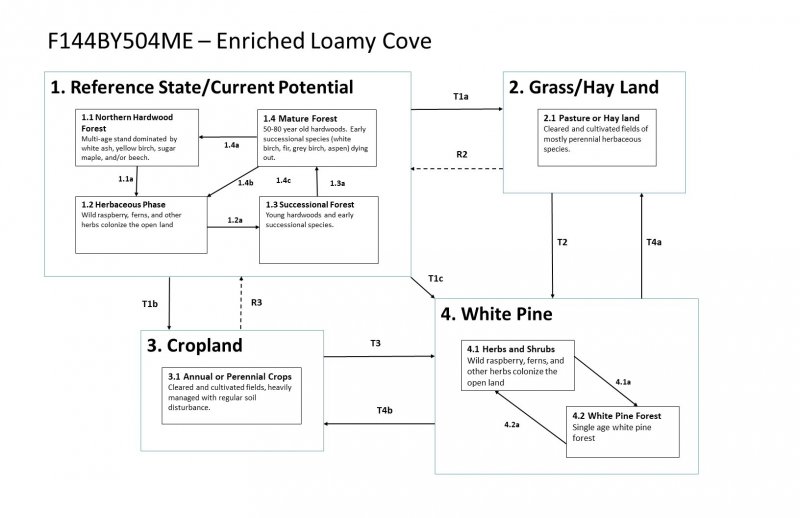
Natural Resources
Conservation Service
Ecological site F144BY504ME
Enriched Loamy Cove
Last updated: 9/27/2024
Accessed: 12/22/2024
General information
Provisional. A provisional ecological site description has undergone quality control and quality assurance review. It contains a working state and transition model and enough information to identify the ecological site.
MLRA notes
Major Land Resource Area (MLRA): 144B–New England and Eastern New York Upland, Northern Part
This major land resource area (MLRA) is in Maine (56 percent), New Hampshire (22 percent), Vermont (14 percent), Massachusetts (6 percent), Connecticut (1 percent), and New York (1 percent). It makes up about 22,728 square miles (58,864 square kilometers). The MLRA consists of a relatively young landscape shaped by the Laurentide Ice Sheet, which covered the region from 35,000 to 10,000 years ago. Rolling hills of dense basal till converge on ridges of shallow bedrock that were scoured by glacial ice. River valleys that were flooded by melting glacial water or seawater house large expanses of glacial outwash and stratified drift in inland areas and, to a lesser extent, glaciomarine and glaciolacustrine sediment deposits in coastal areas. Organic bogs, ablation till, and alluvial flood plains make up the remaining portions of the MLRA.
The soils in this region are dominantly Entisols, Spodosols, and Inceptisols. They commonly have a fragipan. The dominant suborders are Ochrepts, Orthods, Aquepts, Fluvents, and Saprists. The soils in the region dominantly have a frigid soil temperature regime with some cryic areas at higher elevation, a udic soil moisture regime, and mixed mineralogy. Most of the land is forested, and 98 percent is privately owned. Significant amounts of forest products are produced including lumber, pulpwood, Christmas trees, and maple syrup. Principal agricultural crops include forage and grains for dairy cattle, potatoes, apples, and blueberries. Wildlife habitat and recreation are important land uses. Stoniness, steep slopes, and poor drainage limit the use of many of the soils.
Classification relationships
NRCS:
Land Resource Region: R—Northeastern Forage and Forest Region
MLRA: 144B—New England and Eastern New York Upland, Northern Part
Ecological site concept
This site occurs in well-drained coves, drainageways, and other protected areas where nutrients accumulate. These are typically small inclusions within larger hardwood stands and are often not mapped as major soil components. However, the soils and vegetation are distinctive, with a thick dark-colored mineral horizon at the surface indicating high organic matter inputs. White ash, sugar maple, and yellow birch are often abundant on this site, with other rich site indicators such as royal fern and blue cohosh.
Associated sites
| F144BY502ME |
Loamy Till Toeslope The somewhat poorly- and poorly-drained Loamy Till Toeslope site occurs in similar landscape positions as the Enriched Loamy Cove site, but tends not to accumulate quite as many nutrients and water. |
|---|---|
| F144BY501ME |
Loamy Slope (Northern Hardwoods) The Loamy Slope site typically occurs upslope of the Enriched Loamy Cove site. |
Similar sites
| F144BY506ME |
Semi-rich Till Slope The Semi-rich Till Slope site is very similar to the Enriched Loamy Cove site, but it derives its nutrients primarily from calcareous parent material and does not accumulate nutrients due to its more exposed landscape position. Therefore it tends to be less rich than the Enriched Loamy Cove. |
|---|---|
| F144BY507ME |
Semi-rich Till Toeslope The Semi-rich Till Toeslope is somewhat poorly- and poorly-drained, supporting wetter species than the Enriched Loamy Cove site. Otherwise, these two sites may be very similar. |
Table 1. Dominant plant species
| Tree |
(1) Acer saccharum |
|---|---|
| Shrub |
Not specified |
| Herbaceous |
Not specified |
Click on box and path labels to scroll to the respective text.
